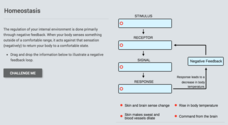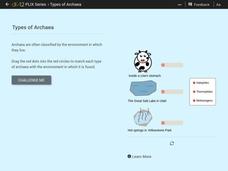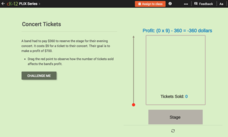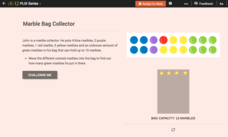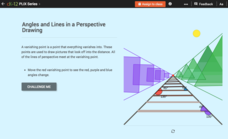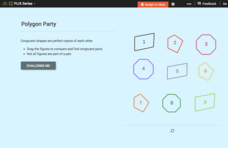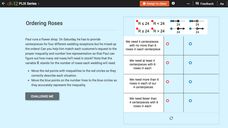CK-12 Foundation
Microscopes: Focal Point
The 1590s saw the invention of the first compound microscope. Scholars learn about how microscopes work and how to properly focus one. The lesson stresses the science fields that use microscopes and the difference between electron...
CK-12 Foundation
Homeostasis
How much negative feedback does a body get daily? The interactive walks through one negative feedback loop, increasing body temperature. Then it challenges scholars to relate this to mechanical feedback loops and disorders that prevent...
CK-12 Foundation
Limiting Factors to Population Growth: Graphing Population Growth
If any of the limiting factors in an environment change, both animal and plant populations also change. The video explains two different models of growth and the impact of limiting factors. It highlights the carrying capacity of an...
CK-12 Foundation
Types of Archaea
One of the few organisms that are classified by the environment in which they live include archaea. The video describes the phylogeny of the group and their major characteristics. It details how they reproduce and discusses the diversity...
CK-12 Foundation
Permutations: Podiums
Add a winning resource to your library. A self-paced interactive has users create a sample space for all possibilities of arranging first- and second-place winners on a podium. The results lead to the realization that permutations...
CK-12 Foundation
Midpoint and Segment Bisectors: Midpoint Map
Discover how to find a midpoint with a conceptual exploration. Scholars manipulate a point to determine the location of a midpoint on a straight line distance between two locations. Later questions extend to determine the...
CK-12 Foundation
Ordered Pairs in Four Quadrants
One quadrant just isn't enough. Pupils learn to plot points in the four quadrants of a coordinate plane using an interactive. A set of challenge questions tests their understanding of the skill.
CK-12 Foundation
Linear and Non-Linear Function Distinction: Domain and Range of a Function
Functions are special types of relations, but what makes them so special? Pupils use an interactive to slide a vertical line across six different graphs. Ten challenge questions then assess understanding of functions.
CK-12 Foundation
Systems of Linear Inequalities: Baking Cookies
Cook up a good resource for systems of linear inequalities. Using an interactive, individuals graph a system of linear inequalities to represent constraints on the number of cookies a person must bake. A set of challenge questions...
CK-12 Foundation
Visual Patterns: Building the Queen's Tower
A resource fit for a queen. Scholars recognize and continue a pattern in towers people are building for a queen. They write and use an algebraic expression for the number of tiles in the towers.
CK-12 Foundation
Applications Using Linear Models: Scuba Diving
Dive into this resource on rates of change and linear models. Pupils use two sliders in an interactive to adjust water temperature and depth. They use a given linear equation to calculate the rate of change in water temperature per unit...
CK-12 Foundation
Linear Inequalities: Concert Tickets
Profit from this resource on linear inequalities. A slider interactive lets users see how the profit on band ticket sales changes with the number of tickets. A set of challenge questions provides some situations for learners to consider.
CK-12 Foundation
Equations with Variables on Both Sides: Rubber Ducky Math
Rubber ducky, you're the one ... to help solve equations. Young mathematicians use an interactive to set up a situation involving rubber ducks. This helps users visualize and solve an equation with variables on both sides.
CK-12 Foundation
Mental Math for Addition and Subtraction Equations: Marble Bag Collector
Don't lose your marbles as your learn about addition and subtraction equations. Pupils investigate the relationship between addition and subtraction by using an interactive. They drag different color marbles into a box and identify...
CK-12 Foundation
Complementary Angles
Here's an interactive that complements your lesson plans. Users of the resource adjust one of the angles in a complementary set to see how it affects the other. A set of challenge questions assesses understanding.
CK-12 Foundation
Linear Pairs: Angles and Lines in a Perspective Drawing
Gain some perspective on linear pairs. Aspiring mathematicians adjust the vanishing point on a perspective drawing. They see the effect on linear pairs of angles and answer five challenge questions based on their observations.
CK-12 Foundation
Vertical Angles
Examine vertical angles from a different angle. Moving one line in an intersecting pair of lines lets users see relationships between vertical angles. They finish by answering some machine-scored questions on the topic.
CK-12 Foundation
Properties of Congruence: Polygon Party
Don't let congruent figures drag you down. Young mathematicians use an interactive to drag figures onto one another to determine if the figures are congruent.
CK-12 Foundation
Absolute Value: Picket Fence Painting
Painting a fence can be useful for more than just making your yard look good. A slider interactive has young mathematicians adjust the number of white fence panels. This activity helps in understanding how absolute value equations...
CK-12 Foundation
Checking Solutions to Inequalities: Ordering Roses
It's important to have the correct number of flower arrangements at a wedding. Scholars match an inequality and a graph given a situation involving roses for wedding receptions. A set of challenge questions checks the matching pairs.
CK-12 Foundation
The Real Numbers: Size of Infinite Sets
The learning opportunities with the resource on infinity are finite, but it's still good to use. Individuals investigate the size of the set of integers and the set of even integers. Conclusion: the two sets have the same size.
CK-12 Foundation
Seasons: Shadow Lengths
Before iPhones and calendars, how did humans determine the seasons of the year? Middle school scientists discover how to use shadows to determine the time of year in an enlightening interactive. Pupils manipulate the sun and examine the...
CK-12 Foundation
Types of Data Representation: Baby Due Date Histogram
Histograms are likely to give birth to a variety of conclusions. Given the likelihood a woman is to give birth after a certain number of weeks, pupils create a histogram. The scholars use the histogram to analyze the data and answer...
CK-12 Foundation
Mental Math to Evaluate Products: Mental Math Halloween Candy
Time to put those mental math strategies into play with an interactive that has learners thinking about how many candies three friends get altogether.

